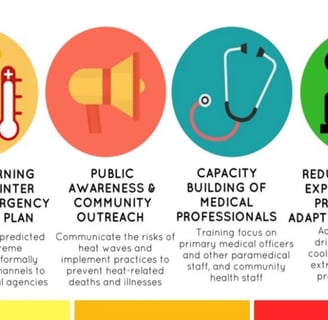Heatwaves in India
INDIAN GEOGRAPHY
Purnima Azad
4/21/20243 min read


What are Heatwaves
Heatwaves are periods of abnormally hot weather, often accompanied by high humidity, lasting from several days to months. They are considered extreme weather events and pose significant dangers to human health, agriculture, and infrastructure. Heatwaves are measured relative to the usual climate of the area and average temperatures for the season, meaning what is considered a heatwave in one region might not be in another. The intensity and frequency of heatwaves have increased across almost every area on Earth since the 1950s, primarily due to climate change. This increase is attributed to the strengthening and prolonged presence of high-pressure areas in the upper atmosphere over regions which trap heat near the Earth's surface.
Recent news highlights the growing concern over heat waves due to their increasing frequency, duration, and intensity, which are being exacerbated by climate change. A global analysis covering the period from 1979 to 2020 found that heatwaves now last, on average, 12 days, up from 8 days at the start of the study period. This trend is expected to continue, with predictions suggesting that the duration could double to 16 days by around 2060. Heatwaves are also becoming more frequent and moving slowly, meaning specific locations endure heatwave conditions more often and for more extended periods. The total distance covered by heatwaves has increased, affecting more significant areas.
In addition to the global perspective, specific regions like India are facing more severe heatwaves. The India Meteorological Department (IMD) has predicted more heatwave days in 2024, with temperatures already reaching high levels in several cities. This is part of a broader trend of rising temperatures and extreme weather events in India, attributed to climate change and phenomena like El Niño. The country has experienced increased heatwave days and is bracing for more intense heat in the coming months.
Heatwaves have a range of adverse effects, including catastrophic crop failures, increased risk of wildfires, widespread electricity outages due to higher air conditioning use, and significant health risks such as hyperthermia and heat stroke. They also exacerbate existing social and environmental inequalities, as seen in the United States, where neighbourhoods with fewer trees and higher populations of people of colour suffer more from heat-related illnesses and deaths.
Criteria for Heat Waves
The heat wave is considered when the maximum temperature of a station reaches at least 40°C for Plains and at least 30°C for Hilly regions. If the average maximum temperature of a station is less than or equal to 40°C, then an increase of 5°C to 6°C from the normal temperature is considered to be heat wave condition. Further, an increase of 7°C or more from the average temperature is considered as severe heat wave condition. If the average maximum temperature of a station is more than 40°C, then an increase of 4°C to 5°C from the average temperature is considered to be a heat wave condition. Further, an increase of 6°C or more is considered as severe heat wave condition additionally, if the actual maximum temperature remains 45°C or more, irrespective of the average maximum temperature, a heat wave is declared.
The health impacts of Heat Waves typically involve dehydration, heat cramps, heat exhaustion and/or heat stroke.
It also causes heat cramps, fatigue, weakness, dizziness, headache, nausea, vomiting, muscle cramps and sweating.
Heat Action Plans (HAPs) to tackle heatwave
Aim: HAPs aim to increase preparedness and lower the adverse impacts of extreme heat by outlining strategies and measures to prepare for, address, and recover from heat waves. The National Disaster Management Authority and IMD reportedly work with 23 States to develop HAPs. Issue with Database: There is no centralized database on HAPs, but at least 23 HAPs exist at the State and city level, with a few States, such as Odisha and Maharashtra, laying out district-level HAPs.


